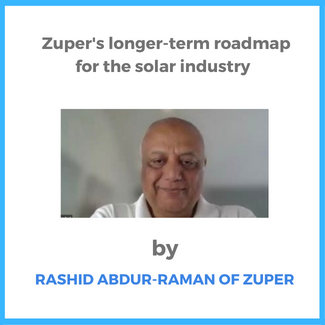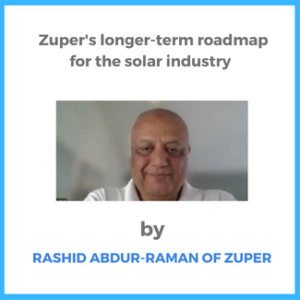Kerim Baran of SolarAcademy talks with Rashid Abdur-Rahman of Zuper, a provider of an end-to-end field service management software application for solar and other field service businesses, in this video. They discuss a number of new features on the horizon, including one that simplifies subcontracting even more and another that assists with the sales aspect of solar. They also talk about the role of AI and the Internet of Things (IoT) in future Zuper development. The video is below.
Here is the video transcription:
Kerim Baran of SolarAcademy: What is on your roadmap for solar segments going forward?
Rashid Abdur-Rahman of Zuper: Our sectors of focus are solar O&M of course, the system integrators. Also the survey companies these pre-sale survey companies – we’re seeing more and more of those. We’re trying to get to a point where somebody can sign up and they have a site ready to use, probably not for the solar integrator first they’re probably going to be last on this. But if you’re a site survey company or if you’re an O&M company all the way up to, “hey this is where my orders are coming in from and we need it coming in automated, assignment, based on skill, based on availability, geography and all of that.
We already have these features. What we’re doing is packaging it so that somebody can sign up and not have to go through this setup process but have something to use. To that end we are also adding some new features. We are evaluating some new features like, for example, one thing that does happen in solar, especially in solar O&M quite a bit is subcontracting. You may be working with a customer you don’t have a base in another state so we are giving you that ability.
I know if there are two Zuper customers. You have a Zuper job order but you need to transfer to somebody else, so you can transfer that to somebody else and then that other company can go through the whole job flow and can manage it internally.
Kerim: So even a solar integrator who did the install job who might not have the resources to do the O&M can subcontract that to a contractor who’s just focused on doing O&M for instance.
Rashid: Exactly. That or a sales company. So far we’re supporting the people who are actually doing the work on-site. We are thinking we’ll also be able to support the companies that specialize only in sales and don’t have the team to actually go out in the field and do this job. They typically rely on subcontractors to get done so we’ll be formalizing that whole visibility across the board rather than have to integrate across. We’ll have the option, you’re a Zuper subscriber so you can send a job from you to the other person where the other person now takes local ownership job and can slice dice, do it whatever. But you as the original originator of the job will have visibility of the status so you can when the job is a complete go and do your billing or whatever needs to happen.
Kerim: Does that even get into – I mean in the sales world that can be really interesting because you can structure commissions. You can structure sharing of commissions: “I started this deal, I sent it to you, you closed it. We shared. The part of sales is one of the most costly parts of solar – the soft cost and sales are just probably the biggest and especially in the world of a little bit more sophisticated commercial business level or residential. But when you get into 500 200 kW size systems and bigger, there are many times more than one salesperson involved, more than one referrer involved and layers to the sales process. I wonder if that would be something to manage as well.
Rashid: I’m not going to rule it out at this stage but we are first focused on getting the actual work stuff being nicely packaged and distributable so you could- For example, somebody takes on a big – the scenarios we want to cover are things like maybe somebody specializes in this aspect of the work and so you know some rooftop repair has to be done before that panel can be installed. But you don’t have the time or bandwidth or your people are busy so you could subcontract that to somebody else so it gets done. But you need visibility so that it is done and done at this cost. So we are focused on that part first, but, who knows, once we have this –
And talking of the future I mean that we are also very interested in IoT. We have done case-by-case integrations. We don’t have standard integration with IoT. We are compatible with the open integration platform but the reason I’m mentioning IoT is because once we have IoT I think we have a great value proposition for even the utility size operations. Where we have the automated monitoring and then – basically an overarching goal for us right now is automation – so we’re talking of how do we reduce the drudgery of the routine work that the dispatcher is doing, for example, the schedule is doing.
So with IoT we would like to use AI and all that stuff to get to the point where there’s a defect and a notice has been alerted and a technician has been notified that you need to be there. And the technician needs to be notified, we look at the geography, we look at the skills, who is closest, who’s free. Does this person have the skills to attend to that piece of equipment? So over the longer term, maybe a year from now, that is also an area of focus that we have. But maybe a year from now we’ll be covering those kinds of scenarios for solar.
We have gone and integrated with devices but these have all been one-offs so far. Maybe you can help us, push us and point us in the right direction that this is a great IoT interface for the solar world and would be happening.
Kerim: All of that IoT stuff will be really needed and very interesting because you know there are more than 2,000 different utility companies in the US which is a very complicated situation in itself with each one with their own rules and their own approach to rolling out solar. More and more property owners, whether it’s a single-family homes or multi-family apartment buildings or commercial or campuses, they’re now starting to put not only solar but also batteries and some of them are choosing to own the batteries. Some of them choose to let the batteries be owned by third-party companies or utilities. Managing all those layers of complexity is going to be something we need to do to have a true distributed power future.
Rashid: Absolutely. And I know those are things that we are sure for right now. So when somebody gets to walk through a typical scenario as applicable and in solar, as anything else. When a customer calls and says they have an issue with installation because Zuper is tracking all your assets, it knows exactly what’s the configuration, what’s the inverter, what’s the battery, what brand of panels. We’ve done things like critter inspection or leak inspections. These are set so you’re seeing the history of the maintenance. When was the last time somebody did something or something was replaced or something was repaired. So the person who is answering, who is taking the call, was taking the ticket from the customer, has all this information at a glance sitting in Zuper itself.
The technician who goes out also has access to the same information. They’re not just shooting in the dark. They can look and say, “This looks like a problem” and they can go through the job history and say, “Oh this has happened before.” All of this is there including photographs. I’m talking about including not just the reports but he can dig into the job itself, the previous jobs and see a photo taken last time, that it looks like a rust spot is new or something. I’m just guessing at stuff here but that’s the goal we already have.
The information should be accessible and now with the AI in the future and the IoT thing, I’m talking about automation. We can use this information to make a smarter decision or help the person make a smarter decision. So baby steps. But that’s the direction longer term that we’re going towards.
Kerim: Well thank you very much for all this information again, Rashid.


